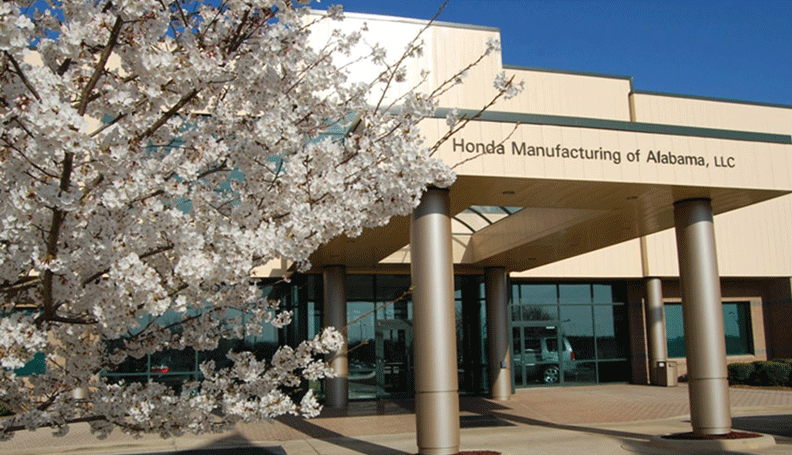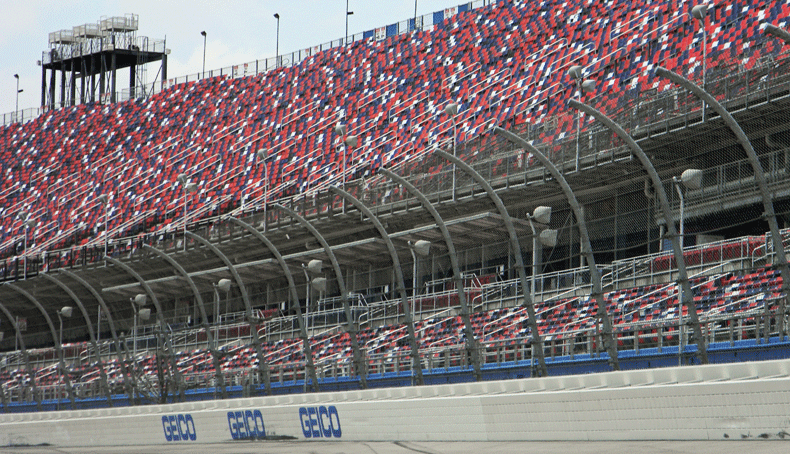(But a big car factory doesn't fix everything)

Photo courtesy of Honda Manufacturing of Alabama
Pass Doodle's Tires, a couple of mini strip malls, several mobile homes, and the Blue Eye Baptist Church, and you'll find the largest factory in Alabama: the Honda automobile assembly plant just outside Lincoln, a community of 6,000 people 45 miles east of Birmingham.
Nestled on 1,350 acres among trees and pastures along U.S. Highway 78, Honda Manufacturing of Alabama is among the biggest economic development prizes in the state's history. Since its 2001 opening, the Japanese automaker's plant has had a profound impact on Talladega County's economy. To cite a few of the benefits:
- Honda employs 4,500 people, the single largest concentration of manufacturing employees in the state.
- The average weekly wage for manufacturing jobs in the county has soared nearly 50 percent, after accounting for inflation, about five times the increase for the nation as a whole, according to numbers from the U.S. Bureau of Labor Statistics (BLS).
- Overall weekly wages in Talladega County have also risen faster than have wages nationwide. "It's largely due to Honda," said Calvin Miller, head of the Talladega County Economic Development Authority.
- Spurred mainly by Honda's arrival, the county claims more than 7,000 jobs connected to the automotive industry, according to Miller.
- The company pays $4.5 million in county school taxes each year. Since Honda's arrival, the county has built three new schools in Lincoln, and the city has added a large park, a new city hall, a fire station, and an industrial wastewater treatment plant to serve Honda, with the capacity to add other large industrial users.

Photo courtesy of Honda Manufacturing of Alabama
Honda took up the slack, but it's no panacea
Perhaps most importantly, Honda's arrival was timely. The carmaker operates two plants at its Talladega County complex, having added a second several years after the original opened, bringing good jobs when the county sorely needed them. Since Honda began construction in the year 2000, plant closings and layoffs—many in textile manufacturing, long a regional stalwart—cost about 4,000 jobs in the county, according to records of the Alabama Department of Economic and Community Affairs, or nearly the same number Honda employs.
In fact, after an Avondale Mills hosiery plant in Sylacauga closed in 2006 and eliminated more than 1,000 jobs, the county's unemployment rate inched up less than 1 percent that year, according to the BLS. "Honda took up the slack," said Larry Barton, mayor of the city of Talladega.
Yet for all the good it has done, Honda has not been a panacea for Talladega County. The county of 81,000 people has consistently suffered an unemployment rate worse than those of Alabama and the United States, despite the influx of automotive jobs.
And the county's median household income remains $8,000 below the state level of $43,000, which is nearly $10,000 less than the national median, according to the U.S. Census Bureau. Similarly, the county's poverty rate of 22 percent is worse than Alabama's 18.6 percent, which is 3 percentage points above the national rate.
So what gives? It's true that those high-wage manufacturing jobs account for roughly a third of the county's 29,000 jobs. But only about a quarter of Honda's 4,500 employees live in Talledega County, according to Miller. The rest commute from surrounding counties, including some from as far away as Jefferson County in Birmingham.
More than just Honda in Talladega County
As crucial as it is, Honda doesn't make up the county's entire economy. The Talladega Superspeedway is probably the most visible business in that part of Alabama. Its two major races each year together attract more than 150,000 spectators.

Photo by Charles Davidson
A manufacturer of aluminum engine blocks, Nemak, employs more than 900 people in Sylacauga, which lies in the southern end of the county. The company does not supply Honda; Nemak ships to the Hyundai assembly plant in Montgomery and the Kia Motors plant in West Point, Georgia.
Talladega County also profits from its topography. Its borders encompass much of the Talladega National Forest, and next door is popular Cheaha State Park, home to the highest point in Alabama. Then there is a large quarry in Sylacauga, where the French company Imerys Performance Minerals employs 275 people to dig marble and convert it to calcium carbonate, an additive used in roof shingles, plastics, textiles, paper, and other products.
While the eastern part of the county is mountainous, the rest is flat Coosa River valley. And flat ground is attractive to economic developers because it costs less to prepare a site for industrial construction, Miller said.
Interstate 20 also runs through the county, close to Lincoln's city limits. Logan-Martin Lake is near the city, which along with Honda helps explain why Lincoln's population has grown nearly 40 percent since 2000, said Lincoln Mayor Claude Kitchin.
Kitchin said that when Honda arrived, locals anticipated the auto plant would spur an even bigger population and economic boom. Unfortunately, those hopes ran smack into the nation's worst economic downturn since the Great Depression. "Some of the effects people expected were delayed," Kitchin said, "but I think they're definitely going to happen."




